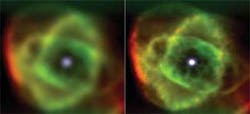ASTRONOMICAL IMAGING: ‘Lucky’ camera creates ground-based images better than Hubble’s

Astronomers have taken pictures of objects that are higher in resolution than anything produced by the Hubble Space Telescope (HST), at a fraction of the cost. Researchers at the University of Cambridge (Cambridge, England) and the California Institute of Technology (Caltech; Pasadena, CA), used an adaptive-imaging technique and a camera called “LuckyCam” to obtain the sharpest pictures of stars and nebulae ever produced from a ground-based observatory (see figure).
Images from ground-based telescopes are limited in resolution by the shimmering of the Earth’s atmosphere, the same effect that makes stars twinkle. Adaptive-optics (AO) systems enable astronomers to subtract much of the smearing of the image, but so far are most useful only in the infrared part of the spectrum. The LuckyCam is an ultra-low-noise, electron-multiplying, charge-coupled-device (CCD) camera developed by Cambridge imaging researcher Craig Mackay to enable high-resolution imaging at visible wavelengths. The camera is called “Lucky” because it relies on chance imaging of an object when it is least affected by poor atmospheric seeing.
To capture the images, the astronomers mounted the camera behind an AO system at the 200 in. (5.1 m) Palomar telescope (Mt. Palomar, CA) to record images at rates of 20 to 100 frames per second. The highest frame rate of 100 Hz limited the image to a tiny 512 × 100-pixel field, while the very slow rate of 20 Hz resulted in a field measuring 512 × 512 pixels, or 20 × 20 arcsec of the sky.
A computer program sorted the vast number of images, discarding the majority of them and saving those that were sharpest following AO corrections. The best images were then combined to produce pictures twice as sharp as those taken from Hubble, a feat never before accomplished.
Twice as sharp as Hubble
Much like at other ground-based telescopes, the images produced at Palomar are roughly 10 times less detailed than those produced by the HST. With the Lucky camera, however, images are two times sharper than those obtained by the space telescope. In some images, Hubble can resolve details with an angular resolution of 0.08 arcsec. Images obtained with the LuckyCam at a similar wavelength achieved a resolution down to 0.04 arcsec. Pictures of the globular star cluster M13, approximately 25,000 light years away, show stars as little as one light day apart. Images of the Cat’s Eye Nebula (eight times closer than M13) reveal details only a few light hours apart.
The cost of the technique is so affordable that amateur astronomers have commonly applied smaller Lucky-type systems and techniques to backyard telescopes since the late 1970s to improve images of planets and deep-sky phenomena. Only now has the system been applied to such huge telescopes. “It’s the more recent advent of both adaptive optics and ultra-low-noise electron-multiplying CCDs that have enabled us to beat Hubble,” says Caltech postdoctoral researcher and team leader Nick Law. “Each on its own can only roughly match Hubble resolution.”
The low cost means that the technique is applicable to telescopes around the globe, especially for much larger telescopes such as those at the European Southern Observatory in Chile, or the Keck telescopes in Hawaii. To that end, astronomers at Caltech and the Jet Propulsion Laboratory (Pasadena CA) are developing the first-ever astronomical adaptive-optics system upgraded to capture visible-light images. Called PALM-3000, the new system will routinely allow the 200 in. telescope at Palomar to outperform the Hubble Space Telescope at visible wavelengths of less than 500 nm (the LuckyCam doesn’t). With state-of-the-art deformable mirrors, sensors, and a powerful laser, the upgraded Palomar AO system will provide finer correction of the atmospheric blurring than any current adaptive-optics system, allowing long-exposure images with the same fine detail as the “lucky” images taken recently. The upgraded instrument could be available as early as 2010.
About the Author
Valerie Coffey-Rosich
Contributing Editor
Valerie Coffey-Rosich is a freelance science and technology writer and editor and a contributing editor for Laser Focus World; she previously served as an Associate Technical Editor (2000-2003) and a Senior Technical Editor (2007-2008) for Laser Focus World.
Valerie holds a BS in physics from the University of Nevada, Reno, and an MA in astronomy from Boston University. She specializes in editing and writing about optics, photonics, astronomy, and physics in academic, reference, and business-to-business publications. In addition to Laser Focus World, her work has appeared online and in print for clients such as the American Institute of Physics, American Heritage Dictionary, BioPhotonics, Encyclopedia Britannica, EuroPhotonics, the Optical Society of America, Photonics Focus, Photonics Spectra, Sky & Telescope, and many others. She is based in Palm Springs, California.
